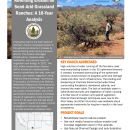Location
States
ArizonaEcosystem
Desert, River/streamIntroduction
The semi-arid grasslands and savannas of the Altar Valley in southern Arizona are vulnerable to erosion, especially from flash flooding during summer monsoon rainstorms. Once erosional processes have begun, cycles of degradation begin and recovery can be slow without intervention. In the early 2000s, A 3.25 mile stretch of road running along a fenceline between the Elkhorn and Las Delicias ranches, located in the Upper Sonoran Desert on sandy-loam, aridic soils, was causing severe erosion and downcutting in the 25 ephemeral streams that it crosses.
The Altar Valley Conservation Alliance (AVCA) is a rancher-led conservation organization in southeastern Arizona. One of the AVCA’s primary goals is to halt the excessive erosion of the Altar Wash and its tributaries to a point where these deeply incised ephemeral streams are once again connected to productive floodplains. Much of this work occurs in the tributaries and uplands of Altar Wash, where the 25 ephemeral washes crossed by the fenceline road between the Elkhorn and Las Delicias ranches are located.
Starting in 2011, the ranch operators of the Elkhorn and Las Delicias ranches, both members of the AVCA, formed a multi-disciplinary planning team with a broad coalition of partner organizations to design and implement restoration treatments along the eroded road and ephemeral streams it crosses. In 2012, the partnership broke ground on the Elkhorn/Las Delicias Watershed Restoration Demonstration Project (Elk/LD Demo Project), a 13,000-acre project. They used restoration techniques of road rehabilitation, upland restoration, and natural channel design, to recreate conditions where natural erosion and deposition processes could resume.
From the very start, the Elk/LD Demo Project was designed as a learning and demonstration site utilizing treatments described by Bill Zeedyk. Participants conducted long-term monitoring of ephemeral streams and surrounding upland areas with erosion control structures, and adjacent streams and uplands without structures, from 2012-2022 to assess the long-term effects of the restoration techniques used. After ten years of monitoring, partners have gathered vital data on the long-term effectiveness of erosion control structures, road rehabilitation, and “Natural Channel Design” in southeastern Arizona.
Key Issues Addressed
The poorly drained fenceline road increased the amount and speed of water reaching the 25 ephemeral streams it crossed, causing severe erosion. As channels formed, they deepened faster than they widened, which prevented water from accessing the surrounding floodplains. The dewatering of the uplands resulted in the dehydration of soils, loss of vegetation, and lowering of the groundwater table. In addition, as water rushed through channels, in-stream vegetation was lost and channels became straighter and less stable, which encouraged the channel to deepen and grow farther upstream as “headcuts.” These headcuts were progressing toward roads and other important infrastructure, degrading in-stream vegetation, and contributing to the degradation of upland vegetative communities, forage, and wildlife habitat.
In addition, the AVCA did not know which treatments would be most effective in the Altar Valley. Although a number of studies of Natural Channel Design techniques have recently been produced (ex: Norman et al. 2022, Callegary et al. 2021), there was a need for more quantitative, long-term monitoring data–especially for comparisons between treated and untreated channels and different types of treatments.
Project Goals
- The Elk/LD Demonstration project was intended as a site where land managers, students, practitioners, scientists, and the public could learn about erosion control and restoration by implementing, maintaining, and monitoring together over the 10-year duration of the project. Specifically, the project set out to document measurable goals, objectives, and treatment plans to be shared publicly and be used as a model for future projects.
- The first goal of the project was to remediate the primary cause of erosion: the degraded fenceline road. The road rehabilitation treatments intended to stabilize the road surface, reduce the frequency and cost of maintenance, and increase the density and diversity of vegetation alongside the roads and in ephemeral streams.
- Because the erosion was caused by water moving into incised channels rather than infiltrating into the uplands, the team implemented treatments to encourage water and sediment to remain in uplands rather than running off into channels. Media lunas (rock erosion control structures) were installed in the uplands surrounding several ephemeral streams to increase the diversity and density of vegetation, and increase sediment, and litter deposited around them.
- The goal of in-stream restoration was to stop further erosion upstream, increase sediment deposition, create or enhance floodplains, increase vegetation cover, and increase width and length of treated channels.
- Overall, the project partners sought to determine which treatments were most effective in reversing degradation and returning ephemeral streams to natural channel function.
Project Highlights
Walking the Land: Participants highlighted the value of collaborative monitoring during the day-long field visits. Walking the land together helped build relationships and common understanding of erosion control techniques.
- Public Demonstration Site: The Elk/LD Demo Project has succeeded in educating land managers, local landowners, and the public about how to install, maintain and monitor the effectiveness of road, upland, and in-stream restoration techniques. Public events have included two full-day field visits, several workshops, and many volunteer events over the years that have reached over 500 people since project initiation in 2011.
- Road Rehabilitation: After 10 years, remote sensing imagery confirmed that road rehabilitation techniques, including installing “rolling dips”, reduced erosion from the road and increased deposition of sediment up to 200 feet downstream.
- Restoring Uplands: (Link to Lia Osanna’s presentation) Qualitative observations of upland rock structures such as media lunas have indicated they increased the diversity and density of vegetation in treated sites compared to untreated sites. They also captured litter, seeds, and sediment upstream of media lunas, increasing soil organic matter content. Quantitative analysis indicated that media lunas increased total soil nitrogen and organic matter content. Soil nitrogen is important for plant growth and organic matter can help increase soil water holding capacity, reduce erosion, and store carbon as a potential climate mitigation strategy.
- Restoring Ephemeral Streams: (Link to Robert Davis’ presentation)Comparisons of remote sensing data from 2011 and 2019 indicated that installing rock detention structures in ephemeral streams helped halt the advancement of headcuts and raisedthe level of the stream bed by slowing the flow of water and increasing sediment deposition.By encouraging the sinuosity and length (meandering) of stream channels via installation of rock baffels, the AVCA team reduced the erosive power of peak flows. This allows the flow of water to increase without downcutting during peak flash floods and allows sediment deposition to raise the stream bed, resulting in a widened stream channel that supports floodplain development, sediment accumulation, and revegetation.
- Supporting Vegetation Takes Time: After 10 years, in-channel rock structures increased cover of herbaceous vegetation and promoted resilience during years of drought (Ossana, 2022). In some cases, in-channel rock structures doubled the cover of herbaceous vegetation. Importantly, vegetation behind rock structures remained during drought years, when much of the surrounding vegetation suffered. These increases were predominantly in native vegetation and may be due to the seeds that were sown by restoration practitioners at the time of installation. The 10-year results contrast with earlier monitoring in 2014, when little change in vegetation was observed.
- Cost Effective Monitoring: Photo monitoring of each ephemeral stream would take one person a full day of field work, plus 1-2 days of office work to properly archive the pictures. Much less time than quantitative monitoring of vegetation and substrate which required 12-15 volunteers spending one full day in the field. Another thing that reduced the cost of monitoring was the GIS system the AVCA created. This GIS system contained a site map with monitoring points, photos from past years, and a way to enter data in real time, which greatly facilitated the effectiveness of data management.
Lessons Learned
During a field day held to review results 10 years after installation, participants who had participated in the project since its design in 2011 remarked that although all treatments were effective, the road rehabilitation and rock media lunas in the uplands were more effective, in terms of cost and impact, than the in-stream rock structures. Also, for media lunas to be effective, they must be carefully constructed along contour lines and the outer ends need to curve upslope in a “mustache” shape to prevent failure.
Structures that were built too high or used rocks that were too large tended to either fail during large rain events or increase erosion downstream when water poured over them. Rock structures should be designed to slow, not stop, the flow of water. Choosing the right size of rocks to put in any given location depends on the flow of water expected during peak flows at that location. Setting stones well during installation can help minimize structure structure
Something temporarily or permanently constructed, built, or placed; and constructed of natural or manufactured parts including, but not limited to, a building, shed, cabin, porch, bridge, walkway, stair steps, sign, landing, platform, dock, rack, fence, telecommunication device, antennae, fish cleaning table, satellite dish/mount, or well head.
Learn more about structure failure (including footer rocks was an especially key component of installation).
It is also important to incorporate funding into initial budget planning to maintain and improve any structures. Structures can be damaged by the first large rain event they experience. As sediment builds behind structures, they can be built up to bolster their effects. Structures in uplands often require attention to the ends of the structures as water begins to flow around their edges, but they tend to require less and less maintenance over time as vegetation stabilizes them and sediment fills in around them.
The longevity and success of this project was made possible by the broad and diverse partnerships that created it. The field days where participants brought their different expertise and observations exemplified the value of collaboration. For example, participants with expertise in rangeland science were able to identify areas with increased erosion, while stream restoration practitioners could see that the erosion was evidence of poor structure construction and described how they could be improved and maintained.
Although long-term monitoring data is key to adaptively manage projects, few funding sources are available for long-term monitoring (which can be costly). The AVCA leveraged partnerships with the University of Arizona and used cost effective photo-point monitoring techniques to overcome these barriers. Students from the University of Arizona’s rangeland management club volunteered to collect data and benefitted by gaining practical field experience. Yearly photo-point monitoring, in sync with bi-modal precipitation, was a cost- and time-effective method. T-posts or large rebar stakes were important to mark long-term photo points as GPS data can lack precision and landscape change over the years.
LiDAR and other remote sensing data are valuable monitoring tools to complement on-the-ground monitoring. It can be difficult to use remote sensing tools to measure sediment changes upstream of erosion-control structures that are one rock high. In these cases, sediment accumulation can be smaller than the detection limits of remote sensing tools (the most accurate products available in the Altar Valley have error margins of around 60cm). Furthermore, landscape features such as overhanging ledges can obscure erosion and deposition near the edges of stream channels. Therefore, both LiDAR and in-field monitoring are key, complementary methods to monitor results of erosion reduction projects.
Next Steps
- Develop a conceptual design to expand the project area downstream and apply these restoration methods throughout the Altar Valley in partnership with engineers, restoration practitioners, and landowners.
- Use results and discussion from the 10-year evaluation to identify where the methods utilized at the Elkhorn/Las Delicias Demonstration area can be applied at a larger scale.
Funding Partners
- Freeport MacMoran Copper and Gold Foundation - Installation, maintenance, and monitoring
- Pima County - Site design and monitoring
- NRCS - Site design and monitoring
- Pima County Regional Flood Control District
- Bureau of Reclamation - Hydrologic modeling and planning of project expansion
Resources
- Field Guide: An Introduction to Induced Meandering by Bill Zeedyk
- Zeedyk, William D., and Clothier, Van (2009). Let the Water do the Work: Induced Meandering, an Evolving Method for Restoring Incised Stream Channels. Santa Fe, NM: The Quivira Coalition. International Standard Book Number: 978-0-9708264-3-5.
- Zeedyk, W.D. (2006). A Good Road Lies Easy on the Land: Water Harvesting from Low Standard Rural Roads. Santa, NM: The Quivira Coalition.
- Altar Valley Conservation Alliance: Elkhorn/Las Delicias Project Area Description
- Altar Valley Conservation Alliance: Elkhorn/Las Delicias Storymap
- Altar Valley Conservation Alliance Open Data Hub
- Elkhorn/Las Delicias Vegetation and Photo Point Monitoring
- 10-year data analysis webinar recording (Passcode: &gCbTF5%)
- Elkhorn/Las Delicias Watershed Restoration Demonstration Project: Planning, installing and monitoring watershed restoration practices in ephemeral arroyos and associated uplands in a flash flood dominated landscape, Altar Valley, Pima County, Arizona (2014)
- Rosgen, D. (2019) Natural Channel Design for River Restoration. Encyclopedia of Water: Science, Technology, and Society
Contacts
- Julia Guglielmo, AVCA: Julia@altarvalleyconservation.org
- Mary Miller, Elkhorn Ranch: Mary@Altarvalleyconservation.org
- Sarah King, AVCA, King Anvil Ranch: Sarah@altarvalleyconservation.org
- Lia Ossana, University of Arizona: lossanna@arizona.edu
Lead Authors
- Ariel Léger, CART Coordinator, University of Arizona: Arielleger@arizona.edu
- Julia Guglielmo, Conservation & Science Director, Altar Valley Conservation Alliance: Julia@altarvalleyconservation.org
- Lia Ossana, PhD Candidate, University of Arizona
Suggested Citation
Léger, A., M., Ossana, L., and Sittig-Guglielmo, J. (2023). “Reversing Erosion on Semi-Arid Grassland Ranches: A 10-Year Analysis.” CART. Retrieved from https://www.fws.gov/project/reversing-erosion-grassland-ranches.






